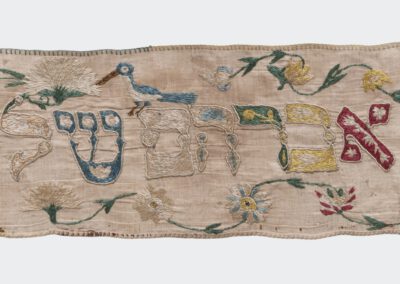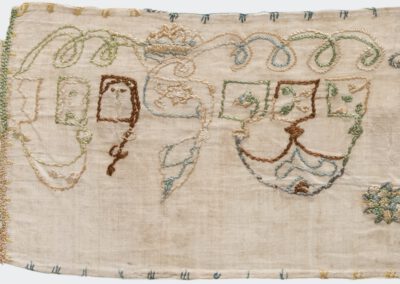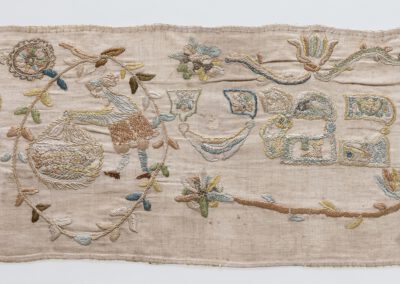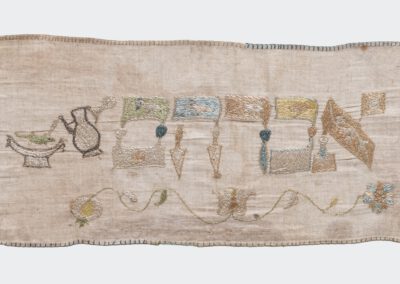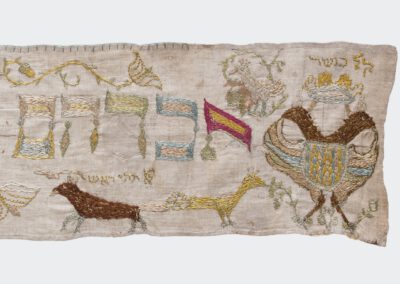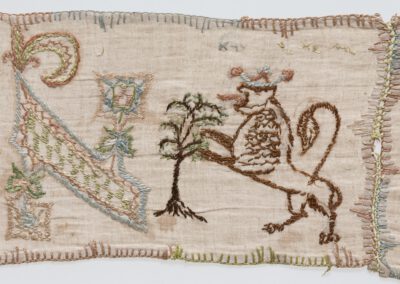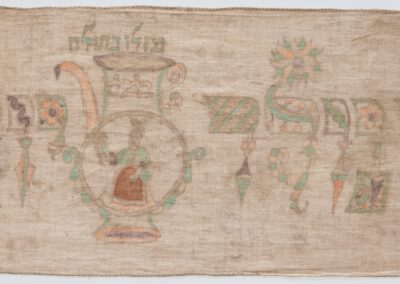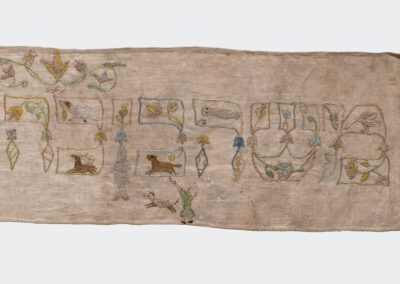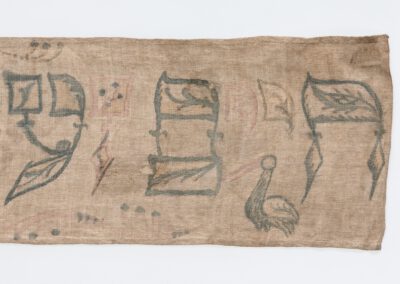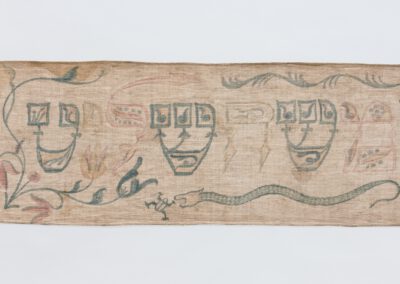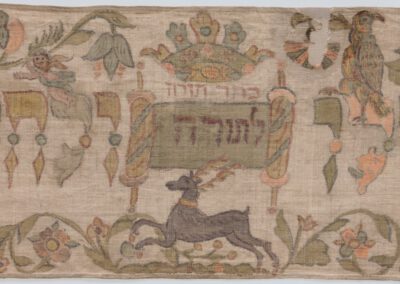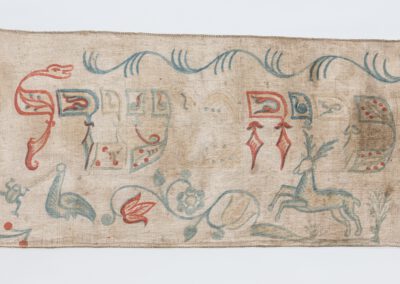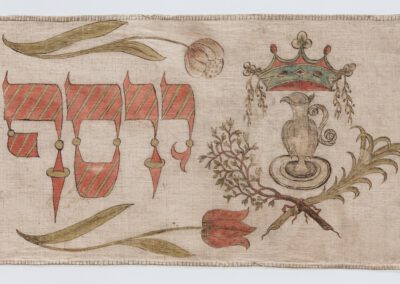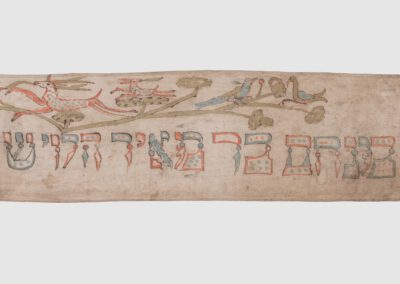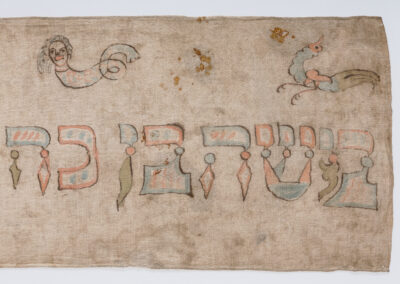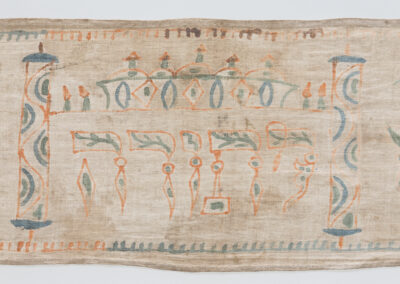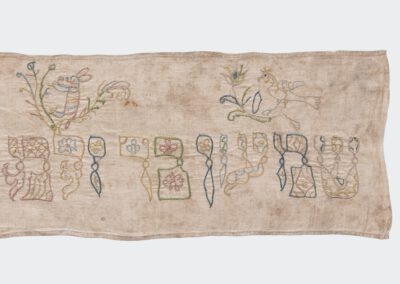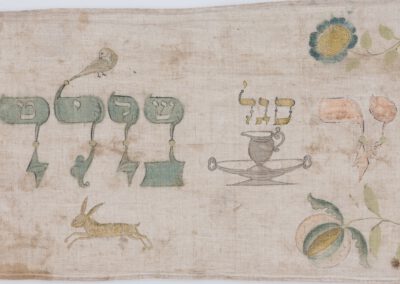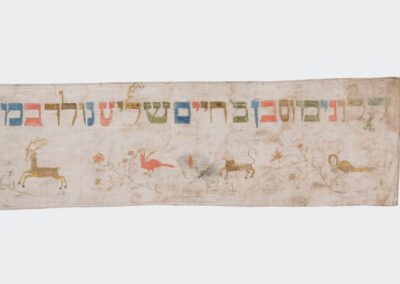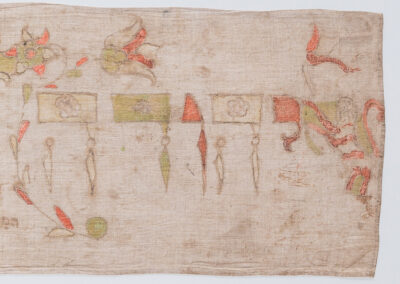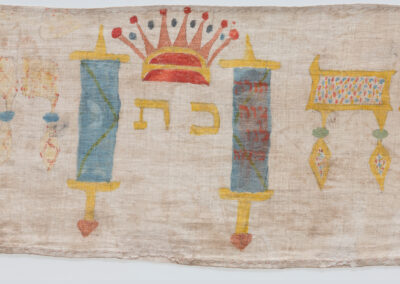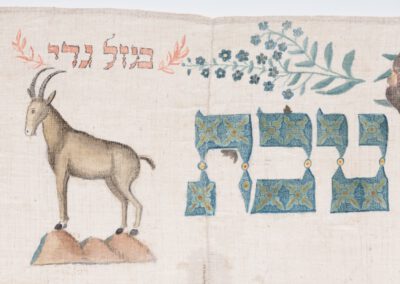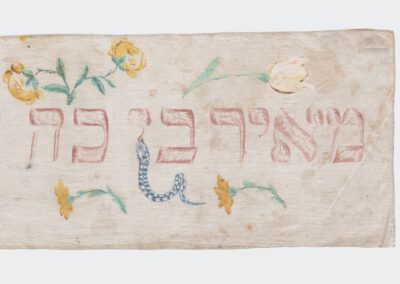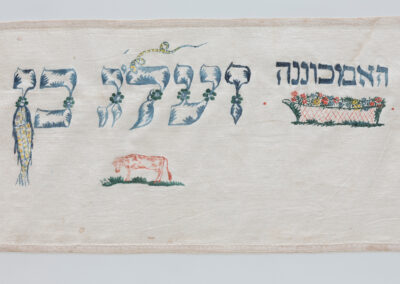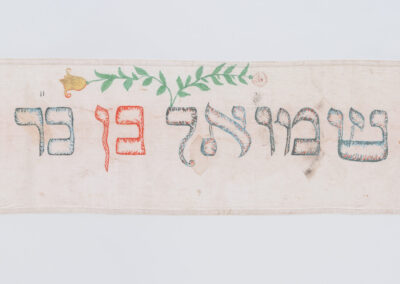Sammlungsbestand Tora-Wimpel Städtisches Museum Göttingen
The Collection of Torah Binders at the Municipal Museum Göttingen
Einer der ersten Tora-Wimpel kam 1897 als Spende in das 1889 gegründete Museum. Stifter war Siegfried Benfey, ein Göttinger Jude und Mitglied des Verwaltungsbeirates des Museums. Ihm war es wichtig, Zeugnisse des jüdischen Lebens und Glaubens in Göttigen zu erhalten. Daher stiftete er noch andere wertvolle Judaika für die Museumssammlung. Im gleichen Jahr müssen noch weitere Wimpel ins Museum gekommen sein. Denn während zuvor keine Wimpel erwähnt werden, heißt es in der Museumschronik zum Jahr 1897: „8.Saal für israelitischen Kultus […] Collection von gestickten und gemalten Thorawickeln v. 1646 bis 1829.“
Bei den genannten Jahreszahlen handelt es sich zwar um fehlerhafte Datierungen, die später korrigiert wurden. Wichtig ist aber die Tatsache, dass es damals im Museum bereits einen eigenen Raum für jüdische Sakral-Objekte gegeben hat. Das Göttinger Museum war wahrscheinlich im deutschsprachigen Raum das erste Museum, das gezielt jüdische Sakralobjekte sammelte und zusammen ausstellte.
Der nächste Hinweis auf Tora-Wimpel findet sich in dem Eingangsbuch aus dem Jahr 1917. Mitten im Ersten Weltkrieg kaufte das Museum eine Sammlung von 18 Tora-Wimpeln an. Sie stammten aus der Synagoge in Adelebsen. Verkauft wurden sie von Leopold Nathan, dem ehemaliger Lehrer der dortigen jüdischen Gemeinde. Er war zu dieser Zeit Soldat. Anscheinend während eines Heimaturlaubes bot er die Wimpel dem Göttinger Museum an.
Die jetzige Sammlung setzt sich also aus dem Altbestand vor 1917 und dem Konvolut aus Adelebsen, das 1917 ins Museum kam, zusammen. Die Geschlossenheit des Adelebser Konvoluts macht heute eine Bestimmung des Altbestandes möglich.
Erst 1949 werden in den Akten des Museums wieder Tora-Wimpel erwähnt. Nach dem Ende des Zweiten Weltkriegs, als in der Shoa nahezu alle sichtbaren Zeichen jüdischen Lebens in Deutschland vernichtet worden waren, reiste Mordechai W. Bernstein durch das Nachkriegsdeutschland. Im Auftrag des Jewish Scientific Institute (YIVO) suchte und dokumentierte er Überreste des einstigen jüdischen Lebens. Dabei besuchte er 1949 auch das Städtische Museum Göttingen. Er erkannte als erster den herausragenden Wert der Göttinger Wimpel-Sammlung, übersetzte die Inschriften und trug entscheidend zur erstmaligen Inventarisierung des Bestandes bei.
Bernstein selbst schreibt 1950:
„Aber die schönste und merkwürdigste Sammlung habe ich im Städtischen Museum in Göttingen vorgefunden. Obwohl dort nur ca. 30 Stück sind, gehören sie doch zu den wertvollsten.
Sie stammen aus den frühen Zeiten, nämlich aus der ersten Hälfte des 17. Jahrhunderts. Man muss sagen, je älter ein Wimpel ist, desto farbenprächtiger und interessanter ist er. Fast jeder Streifen ist ein Kunstwerk.
Diese Sammlung ist Material, ein sehr dankbares sogar, für jeden Kunsthistoriker. Die Figuren und Symbole auf diesen Wimpeln sind ein Schatz für jeden der sich mit Volkskunde beschäftigt.“
Mordechai W. Bernstein: Lebendige Vergangenheit. Der Tora Wimpel: Zeuge jüdischer
Volkskunst, in: Allgemeine Wochenzeitung der Juden in Deutschland, 1.12.1950
(Institut für Zeitgeschichte – Archiv).
english version
The Collection of Torah Binders at the Municipal Museum Göttingen
One of the first Torah binders was donated to the museum in 1897, eight years after it had been founded. The donor Siegfried Benfey, a Jewish citizen from Göttingen, was a member of the administrative advisory board of the museum. It was important to him to add Jewish cultural objects to the museum’s collection. Consequently, he donated several other valuable Judaica items as well. More binders must have come to the museum that same year, as no binders had been previously mentioned and the museum’s 1897 chronicle reads: “8. Room for Judaica … Collection of embroidered and painted Torah binders from 1646 to 1829.”
The dates, which were erroneous, were later corrected. What is important, however, was that there was already a separate room in the museum for Jewish sacred objects. This meant that Göttingen was probably the first museum in the German-speaking world to specifically collect and exhibit Jewish sacred objects together.
The next reference to the Torah binder were additions to the register in 1917. During the First World War the museum bought a collection of 18 Torah binders that came from the synagogue in Adelebsen. They were sold to the museum by Leopold Nathan, a former teacher in the Jewish community there. A soldier, he apparently offered the binders to the Göttingen museum when he was on furlough.
The current collection therefore consists of the pre-1917 collection, and the collection from Adelebsen, which came to the museum in 1917. The coherence of the Adelebsen collection makes it possible today to determine which objects belong to it, and which to the earlier collection.
The Torah binders were not mentioned again in the museum archives until 1949. After the end of the Second World War, when the Shoah had extinguished almost all outward signs of Jewish life in Germany, Mordechai W. Bernstein travelled through post-war Germany. On behalf of the Yiddish Scientific Institute (YIVO) he looked for and documented possible remnants of former Jewish life. His travels brought him to the Municipal Museum Göttingen in 1949. He was the first to recognise the exceptional value of the Göttingen collection of Torah binders, translating the inscriptions and making a decisive contribution to the first inventory of the collection.
Bernstein wrote in 1950:
“But I found the most beautiful and most unusual collection at the Municipal Museum in Göttingen, and although there are only ca. 30 objects, they certainly number among the most precious.
They date back to early times, namely to the first half of the 17th century. One has to say that the older the binder, the more colourful and interesting it is. Nearly every fabric sash is a work of art.
This collection provides material, and very rewarding material at that, for every art historian. The figures and symbols on these binders are a treasure for anyone who studies folklore.”
Mordechai Bernstein: Lebendige Vergangenheit. Der Tora Wimpel: Zeuge jüdischer Volkskunst, in: Allgemeine Wochenzeitung der Juden in Deutschland, 1.12.1950 (Institut für Zeitgeschichte – Archive).
gefördert von der
Alle Fotos Barbara Eismann
